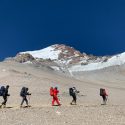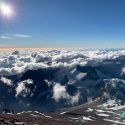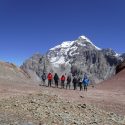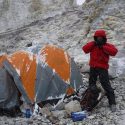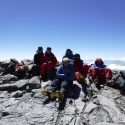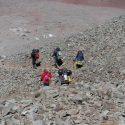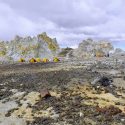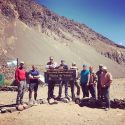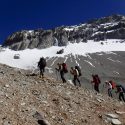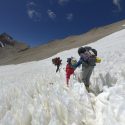Exercise Northern Aconcagua saw nine Army personnel deploy to Argentina in a bid to climb to summit Aconcagua, the highest peak outside the Himalayas at an altitude of 6,962m. This was a challenging and exciting opportunity for all members to attempt such a testing but non-technical trek. The challenge associated with attempting such an endeavour should not be underestimated. For perspective, the highest UK peak is Ben Nevis at an altitude of 1,344m and to attempt to trek up a peak that is over 5 times as high is, for many, unimaginable. For every eight people that attempt the climb, only two are successful; the majority fail due to Acute Mountain Sickness ((AMS) commonly starting at around 3,000m) or insufficient planning and preparation.
Aconcagua was chosen as it is the highest of the world’s seven summits after Everest and offers the climber the best value in terms of altitude gained for effort expended. At least six military expeditions have successfully summited the peak in the last 10 years, which demonstrates that this is entirely achievable. This will undoubtedly be, for the participants, the highlight of their Adventurous Training (and very possibly) military career.
Expedition Leader, Major Pete Barr RLC, first attempted to climb Aconcagua (9,962m) in 2004 but was thwarted at 6,700m as his climbing partner’s AMS began to show signs of developing into High Altitude Cerebral Edema (HACE) forcing a descent. On his posting to the Army Personnel Centre (APC), Maj Barr saw an opportunity to deliver some Type 3 AT, and decided to plan his re-attack of the highest mountain in the world outside the Himalayas.
Now a trained logistician, his original dash-to-the-summit approach of sheltering in a bivi-bag and surviving on Pot Noodles was to be replaced with a meticulously planned expedition up the less used Punta de Vacas route. As the expedition’s leader his ethos was to walk ‘very, very slowly’, acclimatise gradually and maximise the summit window opportunity in the knowledge that conditions on Aconcagua’s windy summit are notoriously changeable.
Following preparatory training on the Winter Mountain Foundation course at Ballachulish for the six novices in the group, the APC team met up with its two instructors (including the AMA’s own Al Mason) and flew to Mendoza, via Buenos Aires, on 11 Feb 19. Two days later we began the three-day trek into the Base Camp at Plaza Argentina (4,215m) with the trail gradually ascending on the banks of the Rio Vacas. As one of the last groups of the season into the Aconcagua National Park we were able to enjoy the scenery undisturbed. In temperatures of up to 35ºC we were delighted to only be carrying day-sacks with mules taking the circa 40kg per person burden of equipment, rations and fuel.
At Base Camp we were superbly supported by Argentine outfitter Fernando Grajales and the logistics provided by their team markedly aided preparation and acclimatisation for expedition’s next stages. At this point our weather watching began in earnest with careful decision making required on when to ascend in order to summit within our four-day window. Over the next eight days we used a ‘climb high – sleep low’ approach to systematically move rations and equipment up the mountain via Camp 1 (5,000m) to Camp 2 (5,475m). All bar one of the group were able to acclimatise well to the altitude and although the ascent was not technical none of use will forget multiple journeys up and down the 400m scree slope below Camp 1.
On 25 Feb we completed our move to Camp 2 and set up camp by mid-afternoon. A little later a team of American climbers descended from a kit-drop at Camp 3 and it was apparent that a 13-year-old boy in their group was suffering from fatigue and mountain sickness. By early evening the boy’s condition had deteriorated towards HACE and under the leadership of Al Mason the APC team had to take the lead in his evacuation. With helicopters unwilling or unable to land this resulted in 4.4 km night time casualty evacuation to rendezvous with a doctor at Base Camp. The combined efforts of the American and APC teams allowed the helicopter evacuation of the boy to hospital the following morning and fortunately he survived.
This evacuation delayed the expedition’s planned ascent, but weather conditions remained favourable and 28 Feb appeared to offer perfect conditions for summitting. We established ourselves at Camp 3 (5,970m) on 27 Feb and after a short night’s sleep awoke at 0430 hrs to push for the summit. After breakfast and melting snow we set out at 0530 hrs reaching the Independencia Refuge shortly after sunrise. Conditions were still and sunny. We donned crampons and continued the gruelling ascent reaching the summit just after 1500 hrs. With one member of the group suffering markedly from altitude sickness we made a slow descent and arrived back at Camp 3 by 2200 hrs.
The following day the team recovered to Base Camp collecting rubbish and equipment as we retraced our steps through Camps 2 and 1. After a celebratory meal provided by Grajales and a night’s sleep we packed our kit for the mules and then began a two-and-a-half-day trek back out to the Punta de Vacas roadhead and then onwards to Mendoza and an awaiting steak (or vegetarian equivalent) and a glass of Malbec.
Approximately 3,500 climbers attempt to summit Aconcagua each year and through a combination of inadequate equipment, the effects of altitude and poor weather conditions only 40% make it to the summit. Through Major Barr’s detailed planning, an extended summit window and excellent teamwork the APC was the first Armed Forces team to summit since 2010. This expedition allowed seven ordinary people a once in a lifetime opportunity to test their mental and physical robustness, in a challenging environment not experienced by many. The high altitude and remote nature of the expedition required focus, determination and commitment to the highest level given the high risk to life in terms of risk of AMS, extreme hot and cold weather as well as dangerous cliff edges and unstable ground.
Maj Gemma MacNeill explains how this expedition tested her to her limits which resulted in her making the difficult decision not to summit in a bid to ensure the rest of her team did;
“This was the hardest thing I’ve ever done! I think of myself as a pretty fit individual, but this expedition tested me physically and mentally to my limits. There was one particular route we had to do four times from Base Camp to Camp 1 which had a brutal shale incline in the last hour of the accent – we aptly named it ‘shale hell’. The lack of oxygen combined with the heavy kit made this climb particularly difficult for me, but I had to keep moving one step at a time for the rest of my team. I couldn’t let them down as they needed me as much as I needed them in order to carry the kit up the mountain. We later ascended to Camp 2, where the weather got colder, windier and the air got thinner. After the events of the rescue of the casualty with HACE, the whole team was mentally and physically exhausted. I had stayed at Camp 2 with two others to look after a member of their team who was suffering shock, and after a day to reflect as well as rest whilst the rest of the team climbed back up from Base Camp, I had realised I had ‘reached my summit’. The rescue had halted our progress by 24 hours, and the thought of ascending 1,00m in the next 24-36hrs in order to make our only summit window made me uncomfortable and I didn’t want to jeopardise my teams’ efforts of summiting. I explained to the team that I wasn’t feeling 100%; I had been suffering headaches and lack of sleep was affecting my motivation, and I wanted the team to have a successful summit attempt without the risk of someone having to drop back to help me if I had gone down. I was content with my decision and proud of myself for reaching an altitude of 5,400m! As we had lost a member the day before from exhaustion whilst helping during the rescue, my decision to not continue actually helped the rest of the team by being able to bring down a lot of kit that had been left behind by another member. This ensured the rest of the team could focus on their summit attempt without the worry of having to carry excess kit unnecessarily. I descended back to Base Camp the same day the rest of the team continued up the mountain where myself, Al and Kenny made sure we could support them where possible by going back up ‘shale hell’ to collect equipment and waste cached by the team on their way up. This made sure the summit team could focus solely on their decent safely. All in all an unforgettable experience, something I can be proud of and use as a platform for future expeditions of a similar ilk if the opportunity arises!’’
Although a massive physical and emotional journey for all involved the sense of satisfaction in participating in a success expedition was immense for all involved. Thanks must go the AMA, The Ulysses Trust, the Army in Scotland Trust and others for the funding support provided.
By Lt Col Tom Armitage

